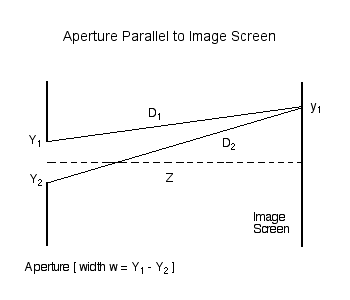Difference between revisions of "User:Tohline/Appendix/CGH/Overview"
(Created page with '<!-- __FORCETOC__ will force the creation of a Table of Contents --> <!-- __NOTOC__ will force TOC off --> =CGH: Philosophical Overview= {{LSU_HBook_header}} ==Propagation of…') |
|||
| Line 3: | Line 3: | ||
=CGH: Philosophical Overview= | =CGH: Philosophical Overview= | ||
{{LSU_HBook_header}} | |||
{{ | ==Slit Diffraction== | ||
===Single Aperture=== | |||
<table border="0" cellpadding="10" align="right"><tr><td align="center"> | |||
<table border="1" cellpadding="5"> | |||
<tr> | |||
<th align="center">Figure 1</th> | |||
</tr> | |||
<tr> | |||
<td align="center" bgcolor="lightgreen">[[File:Aperture3.gif|350px|Chapter1Fig1]]</td> | |||
</tr> | |||
</table> | |||
</td></tr></table> | |||
As has been detailed in an [[User:Tohline/Appendix/CGH/ParallelApertures#One-Dimensional_Aperture|accompanying discussion]], we consider, first, the amplitude (and phase) of light that is incident at a location <math>~y_1</math> on an image screen that is located a distance <math>~Z</math> from a slit of width <math>~w = (Y_1 - Y_2) = 2c</math>. The amplitude is given by the expression, | |||
<div align="center"> | |||
<table border="0" cellpadding="5" align="center"> | |||
<tr> | |||
<td align="right"> | |||
<math>~A(y_1)</math> | |||
</td> | |||
<td align="center"> | |||
<math>~=</math> | |||
</td> | |||
<td align="left"> | |||
<math>~\sum_j | |||
a_j \biggl[ \cos\biggl(\frac{2\pi D_j}{\lambda} + \phi_j \biggr) + i \sin\biggl(\frac{2\pi D_j}{\lambda} + \phi_j \biggr) \biggr] | |||
\, , | |||
</math> | |||
</td> | |||
</tr> | |||
</table> | |||
</div> | |||
where, | |||
<div align="center" id="Distance"> | |||
<table border="0" cellpadding="5" align="center"> | |||
== | <tr> | ||
<td align="right"> | |||
<math>~D_j</math> | |||
</td> | |||
<td align="center"> | |||
<math>~=</math> | |||
</td> | |||
<td align="left"> | |||
<math>~ | |||
L \biggl[1 - \frac{2y_1 Y_j}{L^2} + \frac{Y_j^2}{L^2} \biggr]^{1 / 2} \, , | |||
</math> | |||
</td> | |||
</tr> | |||
</table> | |||
</div> | |||
and, | |||
<div align="center"> | |||
<table border="0" cellpadding="5" align="center"> | |||
<tr> | |||
<td align="right"> | |||
<math>~L</math> | |||
</td> | |||
<td align="center"> | |||
<math>~\equiv</math> | |||
</td> | |||
<td align="left"> | |||
<math>~ | |||
[Z^2 + y_1^2 ]^{1 / 2} \, . | |||
</math> | |||
</td> | |||
</tr> | |||
</table> | |||
</div> | |||
=See Also= | =See Also= | ||
Revision as of 04:25, 28 December 2017
CGH: Philosophical Overview

|
|---|
| | Tiled Menu | Tables of Content | Banner Video | Tohline Home Page | |
Slit Diffraction
Single Aperture
|
As has been detailed in an accompanying discussion, we consider, first, the amplitude (and phase) of light that is incident at a location <math>~y_1</math> on an image screen that is located a distance <math>~Z</math> from a slit of width <math>~w = (Y_1 - Y_2) = 2c</math>. The amplitude is given by the expression,
|
<math>~A(y_1)</math> |
<math>~=</math> |
<math>~\sum_j a_j \biggl[ \cos\biggl(\frac{2\pi D_j}{\lambda} + \phi_j \biggr) + i \sin\biggl(\frac{2\pi D_j}{\lambda} + \phi_j \biggr) \biggr] \, , </math> |
where,
|
<math>~D_j</math> |
<math>~=</math> |
<math>~ L \biggl[1 - \frac{2y_1 Y_j}{L^2} + \frac{Y_j^2}{L^2} \biggr]^{1 / 2} \, , </math> |
and,
|
<math>~L</math> |
<math>~\equiv</math> |
<math>~ [Z^2 + y_1^2 ]^{1 / 2} \, . </math> |
See Also
- Tohline, J. E., (2008) Computing in Science & Engineering, vol. 10, no. 4, pp. 84-85 — Where is My Digital Holographic Display? [ PDF ]
- Diffraction (Wikipedia)
- Various Google hits:
- Single Slit Diffraction (University of Tennessee, Knoxville)
- Diffraction from a Single Slit; Young's Experiment with Finite Slits (University of New South Wales, Sydney, Australia)
- Single Slit Diffraction Pattern of Light (University of British Columbia, Canada)
- Fraunhofer Single Slit (Georgia State University)

|
|---|
|
© 2014 - 2021 by Joel E. Tohline |
